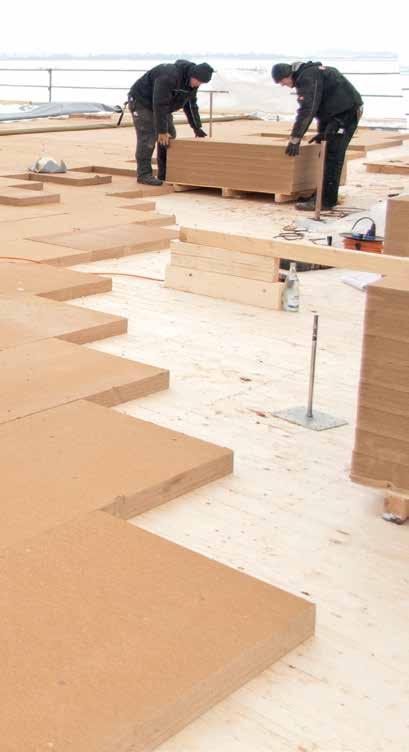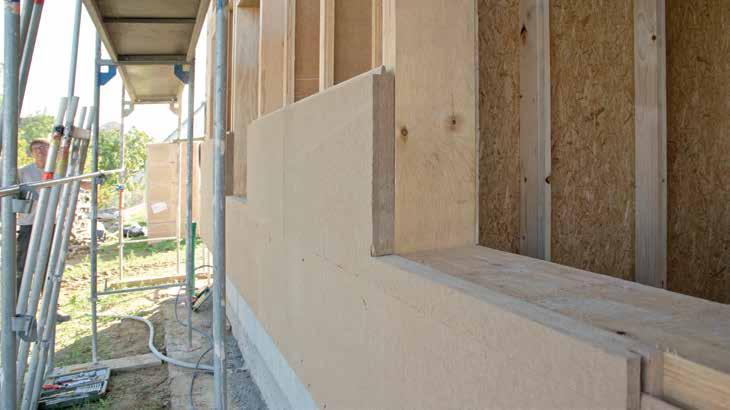
6 minute read
Wood fibre thermal performance and sequestered carbon
Adrian Judd highlights how wood fibre insulation can help achieve sustainable construction.
STEICO Isorel application to a flat roof on Steico new head office. Photo: STEICO
Advertisement

The overriding benefits of using timber in construction have increased its recent use in the UK construction sector. A combination of climate action groups and rising carbon dioxide (CO2) pollution levels have influenced governments worldwide to consider more sustainable construction methods and many are now issuing targets on how to achieve zero carbon within very restrictive time frames.
Globally, building and construction are responsible for 39% of carbon emissions.1 In France it has been announced that all new public-funded buildings must contain at least 50% wood or bio-based materials by 2022 in an ambitious plan for a greener urban life. Why wood? Wood is multifunctional, strong and insulating; it sequesters carbon, helps to reduce operational carbon and is a beautiful natural product.
Wood as a raw material
While the majority of European-sourced timber comes from well-managed forests, offering sustainable and recyclable products, even timber is a precious resource. It is therefore critical that the whole tree is used at some point during the manufacturing process. Wood fibre insulation is produced from trees that are felled either from forest thinning or coppicing programmes that were never destined to grow to full size, which is a great example of how ‘waste’ wood can be valuable. The bark is removed and used as a biomass energy source while the rest of the tree is ground to produce wood fibres for insulation (or for other products such as fibreboard).
Thermal performance and wood
Thermal performance is often explained as how well a home retains heat. This can be the defining factor between a freezing cold home in the winter or a warm and cosy one. However, that statement only defines thermal performance in terms of retaining heat, with no mention of the need to keep excessive heat from entering a building and overheating it. It takes more energy to cool a building using air-conditioning units than it does to heat it. >>
Insulation should be designed so that it allows a building to provide year-round thermal comfort. The natural properties of wood make it an excellent insulant; it has low thermal conductivity, high density and high specific heat capacity.
The UK Building Regulations focus on the U-values achieved as the main measure for efficiency. However, heat can travel by convection, radiation and conduction. Conduction is the focus on the building fabric. Do two walls or roofs with the same U-value perform the same way when considering other factors of thermal performance? No. By using the right materials for the fabric of the building, summer overheating can be controlled, better indoor air quality can be achieved and occupants receive better year-round comfort, as well as reduced energy consumption and bills. The control of summer overheating is commonly known as ‘phase shift’.1
A correctly designed timber structure, incorporating wood fibre sheathings and insulations, is just one way of achieving a better-performing building. This technology is already widely used in other countries, so how can its use be increased in the UK?
Breathability / vapour open
All buildings should offer a comfortable indoor environment and ensuring good indoor air quality requires the right balance between airtightness, vapour control and breathability. It is possible for a building to be both airtight and achieve acceptable air-exchange levels as well as being ‘vapour open’ and breathable. Correctly detailed building fabrics using wood fibre materials allow moisture, which can be detrimental to human health, to pass through the structure of a building without affecting its integrity. A vapour open external layer ensures that no moisture is trapped within the frame, which is good for both the wellbeing of the homeowner and the structure of the building.


STEICO Zell air injected wood fibre insulation to a timber frame structure. Photo: STEICO
Passivhaus principles
Passivhaus is the leading international design standard for low-energy, comfortable, high-quality and affordable buildings. By using timber as part or all of the main structure and incorporating wood fibre insulation, some of the key Passivhaus principles such as super-insulation and thermalbridge-free construction can be achieved while also ensuring the lowest possible impact on the environment.
Sequestered carbon
Carbon sequestration or carbon dioxide removal (CDR) is the long-term removal, capture or storage of CO2 from the atmosphere. This means that during its life a tree will capture and store carbon in its structure. If the timber is used in construction after it is felled, this carbon remains locked away rather than being released during the process of decay.
Instead of carbon offsetting, why not use more of the materials that can have ‘negative’ carbon when calculations are made? Using more timber products in construction automatically removes CO2 from the atmosphere, if you ensure those >>

Protect wood fibre sheathing to external facade of timber frame structure. Photo: STEICO

products come from a sustainable source where felled trees are replaced at least 1:1. If the UK implemented the same legislation as the French Government, an immediate impact would be made in sequestering more carbon in buildings, creating a positive impact on the climate crisis.
Operational carbon
If a dwelling is designed with energy efficiency in mind, using the principles of a fabric-first approach, which considers the components and materials that make up the building fabric before the use of mechanical or electrical services, timber-based products can have a double effect when it comes to carbon. When a building is designed and built using natural materials that offer good year-round thermal comfort, there are not only benefits from the ‘locked in’ carbon of the structure but also energy consumption, which assists in the operational carbon produced in the everyday running of the building.
With the probability that from 2025, new homes in the UK will not be permitted to use gas as a primary source for heating, combined with the rise of electric vehicles, there will be a huge burden on the electrical grid. Therefore, anything that can be done to reduce energy dependency, such as an efficient fabric-first approach in construction, will play a key role in future housing solutions.
Summary
The natural properties of wood-based materials, be it in construction or insulation applications, should make them an automatic choice for the UK construction sector. They provide strong, versatile and resilient structures that ensure high levels of year-round thermal comfort. Wood is also sustainable, recyclable, well-resourced and managed, and stores carbon at source. n
About the author
Adrian Judd Director Steico
Further reading
To find out more about timber and sustainability, visit www.trada.co.uk/sustainability.
References
1.www.steico.com/fileadmin/steico/content/pdf/Marketing/UK/
Heat_protection/STEICO_heat_protection_EN_i.pdf










